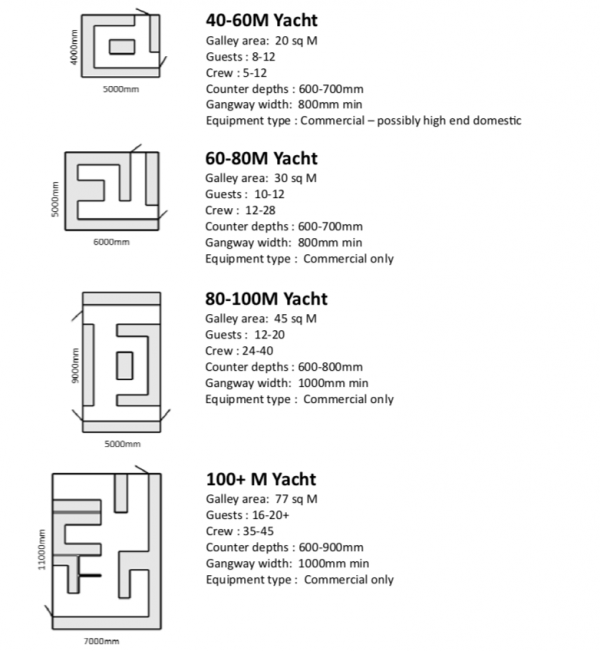In the role of a Superyacht Chef, the working environment directly influences performance. With minimal space, it’s vital that a Superyacht galley is designed effectively. GN-Espace Systems specialise in yacht galley designs and are here to discuss how to make galleys better.
As shipyards and owners compete with each other to build the largest Superyacht, it is fair to say that the general mood amongst yacht chefs is a positive one. Larger Superyachts typically mean more room in the yachts’ working areas. And of course, this translates into bigger galleys with more storage spaces, tools, equipment, and so on.
Historically, in the days when a well-endowed yacht was just a shade over 50m, owners were reluctant to sacrifice living space for crew and other working areas. For example, if you step onboard a classic pre-1990 Feadship, you’ll often find a galley that largely represents a home-style kitchen with few mod-cons.
Let’s just say, cruising a Superyacht was a different game back then. There were fewer boats on the water and ample space in the marinas. Guests had fewer worries for safety and privacy, which made venturing ashore for restaurant meals more common.
However, fast forward to now and things have changed a lot, and guests look forward to indulging in luxury cuisine on board. The demand for this means Superyacht builders have to ensure the yacht galleys’ designs are a slick, near-commercial operation from the get-go.
So, what is important when designing the ideal yacht galley?

It doesn’t take a degree in architecture to dream up a functioning yacht galley space. But, equally, it would be foolish to address a layout without first consulting a professional yacht chef. Most of the chefs we spoke to during the creation of this piece agreed on one point…Professional consultationis the most important factor in making sure a new-build yacht galley meets its maximum potential.
Charter yachts will see stews and stewardesses having access to the yacht’s galley regularly. Because of this, it’s good to keep fast-moving traffic in mind when designing galley systems. Some chefs will say that this can be done by designing cooking equipment space, preparation areas and the overall chefs area at one end of the galley. While over the other side will be an area for collecting food/disposing of food. This is to reduce the hazard of crew and chefs getting under each other’s feet.
To further extend on galley equipment space – the majority of Superyacht galleys feature designs in which tools and applicants are out of the way under the counter and in cupboards. By doing so, it creates a larger work area.
“Space is the most important thing to get right in the galley. If the allocation of space isn’t quite right, this will have a knock-on effect on the overall design and working environment.” – Ralph Olingschlaeger, director at GN Espace.
Entrepreneur galley designer, Julian Kimberley and CEO of GN-Espace discloses:
There is still vast scope in the marketplace for specialist contractors in these types of working areas onboard yachts. This is evident through the success of similar businesses such as Superyacht gym designers Gym Marine, and yacht tender suppliers Superyacht Tenders. It’s a prime example that the industry is still very much willing to listen to experts.
Luxury blue water cruisers @Gunfleetyachts exhibiting in Hall 16 at @nonstopboat. Equipped with GN Espace galley. See us in Hall 11 F04 pic.twitter.com/wUbmSkQYiv
— GN Espace (@GN_Espace) January 17, 2017
GN Espace has been operating in the Superyacht industry for over 10 years. They’ve overseen the evolution of Superyacht galleys, as yachts become larger and larger. From speaking with Julian, he uncovered that the yacht design industry has now embraced the idea of function-over-form. And, he goes as far as saying that this is the key to designing a first-class yacht galley.
“In the past, these galleys were designed as home-style kitchens, made to look beautiful with plenty of wood and marble. Practically speaking though these galleys are commercial kitchens nowadays, more akin to restaurant or hotel cooking facilities. This means that we are urging designers to include more surfaces and units in stainless steel. As well as to take more time studying the layout, to ensure better levels of food hygiene and efficiency.” – Julien

“Preparation is key. I ensure that at the beginning of the season or before a charter I stock up with just about every conceivable thing a guest could request. We have always been lucky to have ample freezer space and large dry stores on the yachts I’ve worked with.
When I have been presented with tighter storage solutions, I have employed multiple-use pieces of equipment to make room for more provisions. Having the right ingredients is much more important than having a special gadget when space is at a premium” – Jules Wigley, a kiwi chef who has enjoyed a career cooking onboard some of the most high profile yachts in the Superyacht industry.
Whatever the future holds for the new-build market, one thing is for certain; Despite the importance of space in the galley design phase, it needs to be created with a technical mindset, as opposed to a style-driven approach.
Visit www.gn-espace.com for more on specialist yacht galley designs, systems and equipment.
For the latest crew mess news, click here.









.gif)


.gif)







